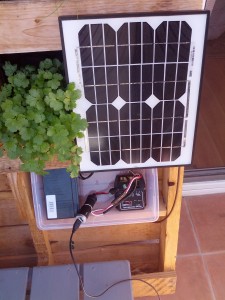Using what I learned from my previous 30W system, I decided to create an ‘ideally sized’ system for low powered devices. The device I had in mind is a low-cost router that is very popular with the OpenWRT community, the TP-Link 703N. This ~$25 router consumes about 1 Watt of energy (~200mAh @ 5V) and is powered via a standard micro USB port.
The solar setup for this system was sourced entirely from Amazon. It consists of four components, which you can see in the image above: A 10W solar panel, 8Ah 12V battery, charge controller, and a cheap 12-24V->5V power regulator which provides 2 USB ports, providing up to 2.1Amps @ 5V.
Total cost on the electrical side, sourcing entirely from Amazon:
$39.99 + $20.79 + $17.59 + $9.12 = $87.49
The only cost left out is wire and connectors from my parts drawers, the most significant in this case being a salvaged cigarette lighter port which would run you $2-4 on ebay or Amazon.
Based on my calculations, this system could run 24/7/365, if it were positioned ideally (here in sunny California) and there were never more than 2 days in a row without sun. It would continue to run for 4 days in a row without sun, but this would damage the battery, so I use an Arduino with a TIP120 transistor to cut power to the 703N, preventing battery over-discharge.
My preferred battery type is an absorbed glass mat or gel battery. AGM batteries are sealed, do not requiring watering, and can be used in any orientation. They can even be carried in checked baggage on airplanes, so your system is truly portable! This is useful for rapid deployments to disasters or just for traveling to a conference with a demo sized solar system.
Make sure your battery is a deep cycle battery. If you keep the average cycle at about 50% discharge, you will have a long lifetime at a low cost. Over-discharging will reduce the battery lifespan, so my systems are designed to have 2 days of buffer– that is, run for 48 hours with no sun before discharging below 50%.
The panel in this case is sized to generate enough power from 1 day of winter sun to charge the battery from 50% to 100%, while simultaneously powering the TP-Link 703N. That means we generate 48Wh per day to charge the battery, and 24Wh per day to run the 703N.
The calculation I used to figure that out is below, and also explained a bit more fully in my presentation at the 2013 International Summit for Community Wireless Networks. Here’s a PDF download of the slides from my presentation: Solar Power Basics
The calculation below takes as input:
- The power consumed by the 703N
- The hours of sun on the ‘worst-case’ day, which you can find using a sun chart.
- The number of days in a row without sun you expect.
It then determines how large of a battery and solar panel you will need. You’ll notice the required battery capacity is four times the daily energy usage, providing ample buffer and preventing over-discharge. The 10W solar panel will be able to charge the battery from half to full with seven hours of ideal sun per day, while using the 703N as a Wi-Fi access point.
| TP-Link 703N | ||
| Power consumption | 1.0049 | Watts |
| Max days without sun | 2 | days |
| Hours of sun per day in winter | 8 | hours |
| Daily energy usage | 24.1176 | Wh |
| Required battery capacity | 96.4704 | Wh |
| @12V | 8.0392 | Ah |
| Charge from 50% to full: | 48.2352 | Wh |
| Run you device for a day: | 24.1176 | Wh |
| Total power generation required per day: | 72.3528 | Wh |
| Size of panel required @ 85% charge controller efficiency | 10.6401176470588 | Watts |
